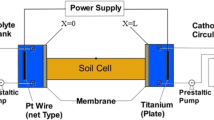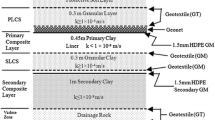Abstract
This paper presents a numerical model based on explicit finite difference method for contaminants transport under electrokinetic remediation process. The effect of adsorption, precipitation and water auto-ionization reactions was considered with a set of algebraic equations. Also the effect of electrolysis reaction in anode and cathode cells was considered with appropriate boundary conditions. The model predictions are compared with experimental results of electrokinetic lead removal from kaolinite in the literature. The coefficient of determination and index of agreement between the lead concentration of experimental result and model prediction were 0.974 and 0.884, respectively. The coefficient of determination and index of agreement between the pH value of experiment and the pH prediction were 0.975 and 0.976, respectively.











Similar content being viewed by others
References
Falamaki A, Tavallali H, Eskandari M, Farahmand SR (2016) Immobilizing some heavy metals by mixing contaminated soils with phosphate admixtures. Int J Civil Eng 14(2):75–81
Virkutyle J, Sillanpaa M, Latostebmaa P (2002) Electrokinetic soil remediation-critical overview. Sci Total Environ 289(1–3):97–121
Kim SO, Moon SH, Kim KW (2001) Removal of heavy metals from soils using enhanced electrokinetic soil processing. Water Air Soil Pollut 125(1):259–272
Vereda-Alonso C, Rodríguez-Maroto JM, García-Delgado RA, Gómez-Lahoz C, García-Herruzo F (2004) Two-dimensional model for soil electrokinetic remediation of heavy metals: application to a copper spiked kaolin. Chemosphere 54:895–903
Reddy KR, Claudio C (2009) Electrochemical remediation technologies for polluted soils sediments and groundwater. Wiley, Hoboken
Alshawabkeh AN, Acar YB (1996) Electrokinetic remediation. II: theoretical model. J Geotech Eng ASCE 122(3):186–196
Haran BS, Popov BN, Zheng G, White RE (1997) Mathematical modeling of hexavalent chromium decontamination of low surface charged soils. J Hazard Mater 55(1–3):93–107
Jacobs RA, Sengun MZ, Hicks RE, Probstein RF (1994) Model and experiments on soil remediation by electric fields. J Environ Sci Health Part A Environ Sci Eng Toxicol 29(9):1933–1955
Kim SO, Kim JJ, Yun ST, Kim KW (2003) Numerical and experimental studies on cadmium (II) transport in kaolinite clay under electrical fields. Water Air Soil Pollut 150(1–4):135–162
Kim SO, Kim JJ, Kim KW, Yun ST (2004) Models and experiments on electrokinetic removal of Pb(II) from kaolinite clay. Sep Sci Technol 39(8):1927–1951
Park Jin-Soo, Kim Soon-Oh, Kim Kyoung-Woong, Kim BR, Moon S-H (2003) Numerical analysis for electrokinetic soil processing enhanced by chemical conditioning of the electrode reservoirs. J Hazard Mater 99(1):71–85
Hafiz A (2004) Evaluation and enhancement of electro-kinetic technology for remediation of chromium copper arsenic from clayey soil. PhD thesis, Florida state University
Mascia M, Palmas S, Polcaro AM, Vacca A, Muntoni A (2007) Experimental study and mathematical model on remediation of Cd spiked kaolinite by electrokinetics. Electrochim Acta 52:3360–3365
Al-Hamdan AZ, Reddy KR (2008) Electrokinetic Remediation Modeling Incorporating Geochemical Effects. J Geotech Geoenviron Eng 134(1):91–105
Yeung AT, Hsu CN, Menon RM (2011) Electrokinetic extraction of lead from kaolinites: I. Numerical modeling. Environmentalist 31:26–32
Ghasemzadeh H (2008) Heat and contaminant transport in unsaturated soil. Int J Civil Eng 6(2):90–107
Mitchell JK (1993) Fundamentals of soil behavior, 2nd edn. Wiley, New York
Eykholt GR, Daniel DE (1994) Impact of system chemistry on electroosmosis in contaminated soil. J Geotech Eng 120(5):797–815
Paz-García JM, Johannesson B, Ottosen LM, Ribeiro AB, Rodríguez-Maroto JM (2011) Modeling of electrokinetic processes by finite element integration of the Nernst–Planck–Poisson system of equations. Sep Purif Technol 79:183–192
Lorenz PB (1969) Surface conductance and electrokinetic properties of kaolinite beds. Clays Clay Miner 17:223–231
Alshawabkeh AN (1994) Theoretical and experimental modeling of removing contaminants from soils by an electric field. PhD thesis, The Louisiana State University, Baton Rouge, LA, USAs
Daniel DE (1993) Geotechnical practice for waste disposal. Chapman & Hall, London
Yong RN, Warkentin BP, Phadungchewit Y, Galvez R (1990) Buffer capacity and lead retention in some clay materials. Water Air Soil Pollut 53(1):53–67
Cao X (1997) Modeling electrokinetically enhanced transport of multispecies in porous media under transient electrical field. MSc thesis, Lehigh University, Bethlehem, PA, USA
Wilkowe A (1992) A modified finite difference model of electrokinetic transport in porous media. Master of Science thesis, Lehigh University
Asadi A, Huat BBK, Moayedi H, Shariatmadari N, Parsaie A (2011) Electro-osmotic permeability coefficient of peat with different degree of humification. Int J Electrochem Sci 6(11):4481–4492
Lide DR (2010) CRC handbook of chemistry and physics: a ready-reference book of chemical and physical data. CRC Press, Boca Raton
Acar YB, Robert JG, Akram AN, Marks RE, Puppala S, Bricka M, Parker R (1995) Electrokinetic technology: basis and technology status. J Hazard Mater 40(2):117–137
Author information
Authors and Affiliations
Corresponding author
Rights and permissions
About this article
Cite this article
Asadollahfardi, G., Rezaee, M. & Tavakoli Mehrjardi, G. Simulation of Unenhanced Electrokinetic Process for Lead Removal from Kaolinite Clay. Int. J. Civ. Eng. 14, 263–270 (2016). https://doi.org/10.1007/s40999-016-0049-7
Received:
Revised:
Accepted:
Published:
Issue Date:
DOI: https://doi.org/10.1007/s40999-016-0049-7




